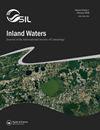大小问题:亚马逊小型溪流虾的栖息地使用取决于体型吗?
IF 2.3
3区 环境科学与生态学
Q1 LIMNOLOGY
引用次数: 0
摘要
摘要自然选择是生物体大小和形状的关键驱动因素,因此资源利用通常取决于个体大小。在种群和组合中,有压倒性的证据表明,大小或阶段对生态位的特定影响主要发生在栖息地和食物维度上。E.P.Silva等人2019年的一项研究“亚马逊雨林溪流系统中淡水虾物种的栖息地隔离”表明,亚马逊小型溪流虾物种在50米溪流范围内只表现出轻微的栖息地隔离,但这项研究没有考虑到物种内和种间体型差异对栖息地选择的可能影响。我们通过夜间观察调查了不同大小的同种虾在栖息地使用方面是否重叠,以及大小相似的异源个体在栖息地使用上是否不同。使用广义线性混合模型来测试体型和栖息地特征之间的可能关系,使用多元线性分析和基于潜在变量模型的排序来测试栖息地使用的种内和种间差异。不同大小和物种的虾对栖息地特征的平均使用频率不同,但栖息地成分的使用有很大的重叠。小个体的种间栖息地重叠大于大个体。我们的研究结果表明,体型并不是虾种群和组合中栖息地分离的主要驱动因素,尽管它提供了不同体型同种动物在栖息地使用方面细微个体遗传变化的证据,以及体型相似的不同物种个体之间的差异。本文章由计算机程序翻译,如有差异,请以英文原文为准。
A matter of size: Does habitat use depend on body size in Amazonian small-stream shrimp species?
ABSTRACT Natural selection is a key driver of organism size and shape, so resource use often depends on individual size. Among populations and assemblages there is overwhelming evidence that size- or stage-specific effects on niche occur mainly in habitat and food dimensions. A 2019 study by E. P. Silva and others, “Habitat segregation among freshwater shrimp species in an Amazonian rainforest stream system,” showed that Amazonian small-stream shrimp species show only slight habitat segregation at the scale of 50 m stream reaches, but that study did not take into account possible effects of intraspecific and interspecific differences in body size on habitat selection. We investigated through nighttime observations if conspecific shrimp of different sizes overlap in habitat use and whether heterospecific individuals of similar sizes differ in habitat use. Generalized linear mixed models were used to test possible relationships between body size and habitat features, and multivariate linear analysis and latent-variable model-based ordination were used to test for intraspecific and interspecific differences in habitat use. Mean frequency of use of habitat features differed among shrimp of different sizes and species, but use of habitat components strongly overlapped. Interspecific habitat overlap was greater among small individuals than large individuals. Our results indicate that size is not a major driver of habitat segregation in shrimp populations and assemblages, although it provides evidence of subtle ontogenetic shifts in habitat use by conspecifics of different sizes as well as differences between individuals of different species with similar sizes.
求助全文
通过发布文献求助,成功后即可免费获取论文全文。
去求助
来源期刊

Inland Waters
LIMNOLOGY-MARINE & FRESHWATER BIOLOGY
CiteScore
6.10
自引率
9.70%
发文量
34
审稿时长
>12 weeks
期刊介绍:
Inland Waters is the peer-reviewed, scholarly outlet for original papers that advance science within the framework of the International Society of Limnology (SIL). The journal promotes understanding of inland aquatic ecosystems and their management. Subject matter parallels the content of SIL Congresses, and submissions based on presentations are encouraged.
All aspects of physical, chemical, and biological limnology are appropriate, as are papers on applied and regional limnology. The journal also aims to publish articles resulting from plenary lectures presented at SIL Congresses and occasional synthesis articles, as well as issues dedicated to a particular theme, specific water body, or aquatic ecosystem in a geographical area. Publication in the journal is not restricted to SIL members.
 求助内容:
求助内容: 应助结果提醒方式:
应助结果提醒方式:


